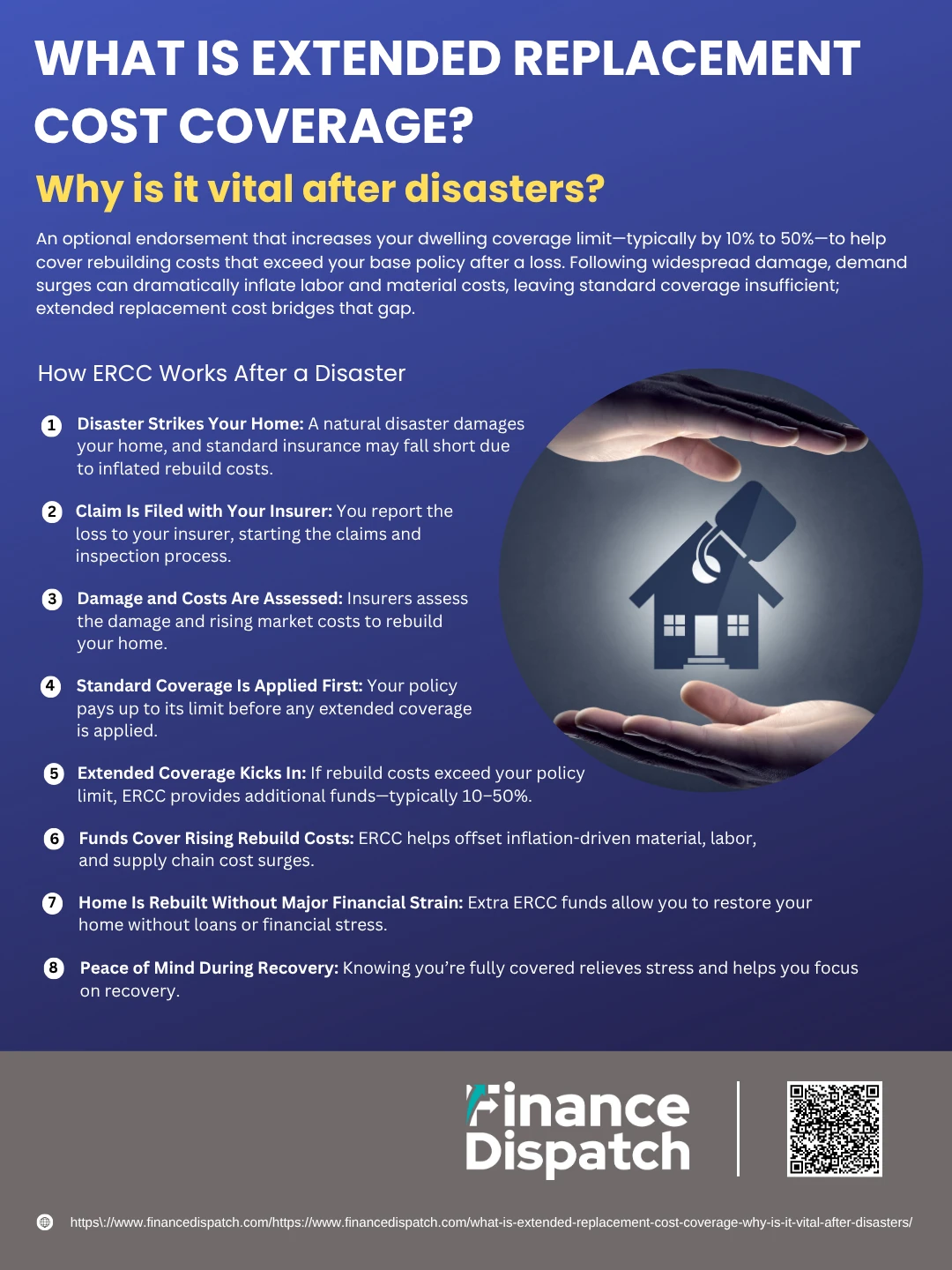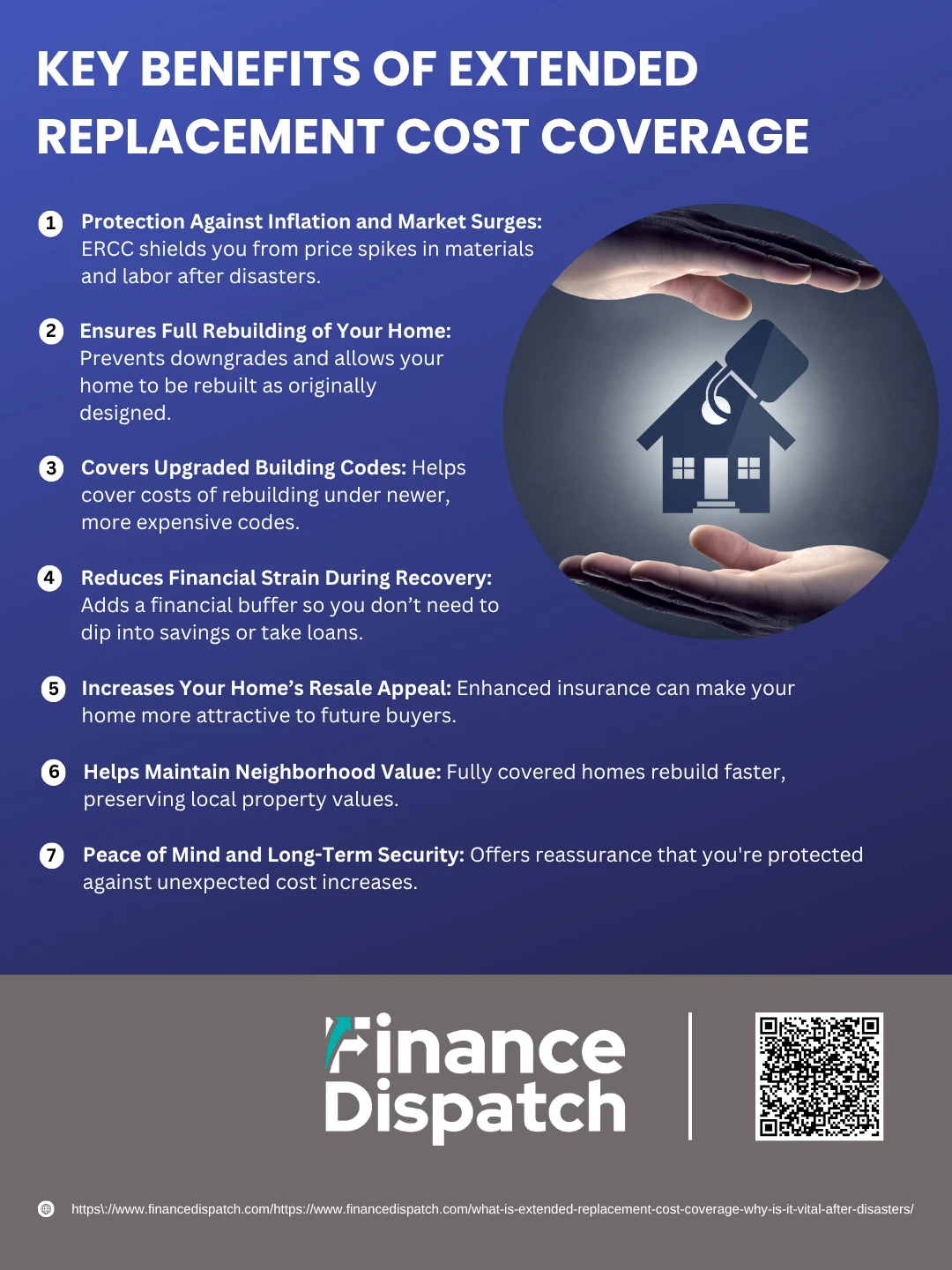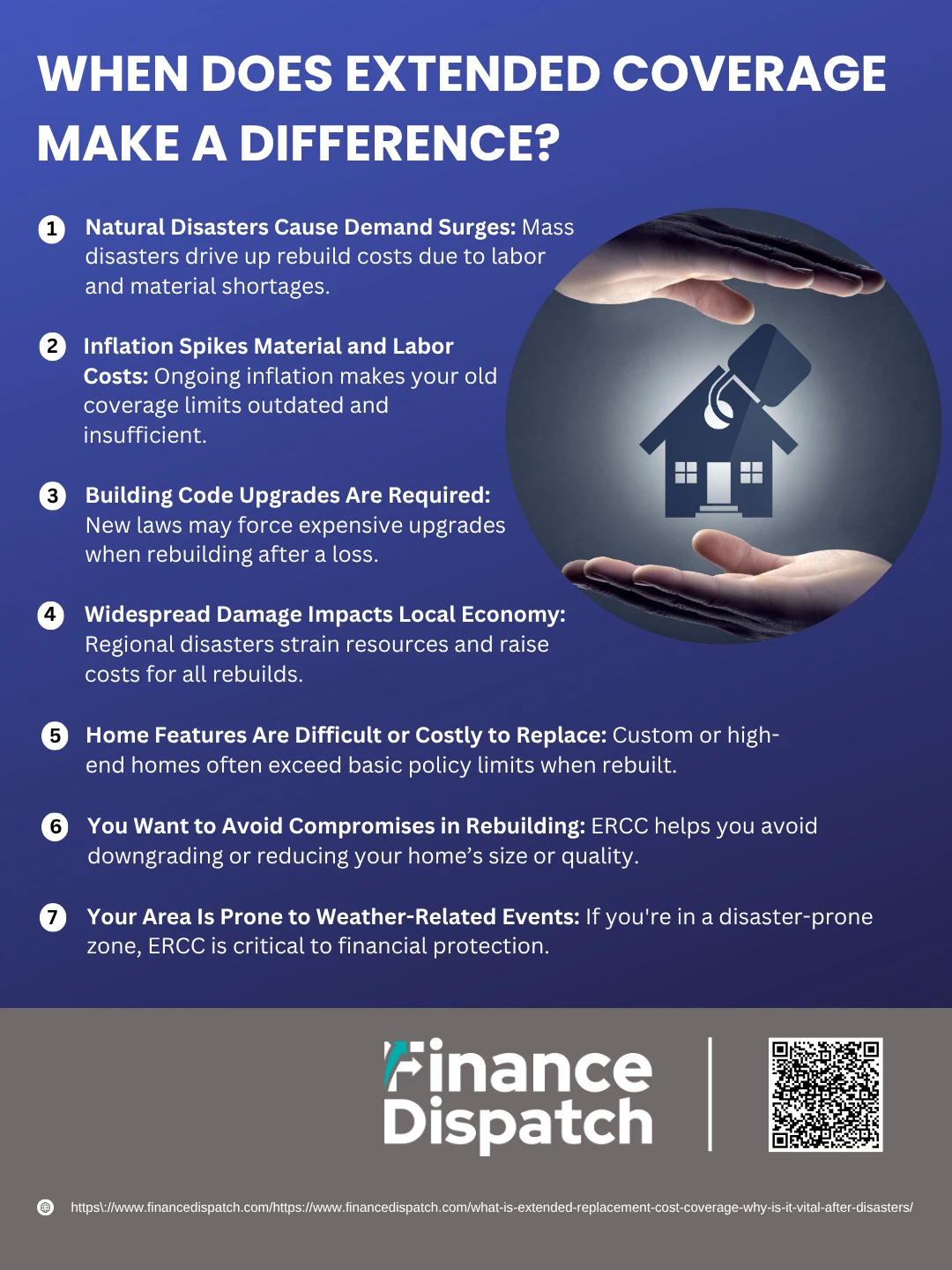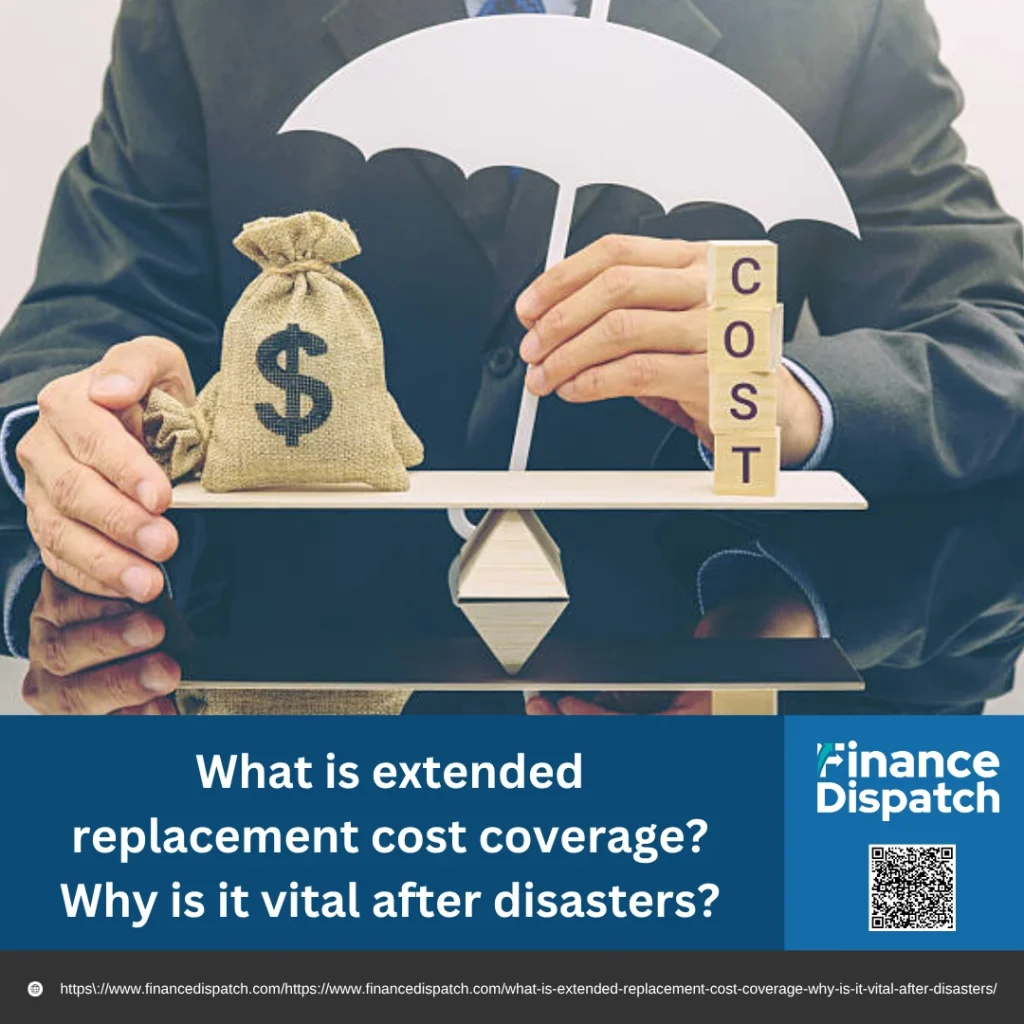When disaster strikes, the cost of rebuilding a home can skyrocket—often surpassing the limits of a standard homeowners insurance policy. This is where extended replacement cost coverage steps in. As an optional but powerful add-on to your insurance plan, it provides a critical financial cushion that covers rebuilding costs beyond your policy’s stated limits. Whether triggered by inflation, building code changes, or sudden spikes in labor and material costs following a catastrophe, extended replacement cost coverage helps ensure you’re not left paying out of pocket when you’re most vulnerable. Understanding this coverage is essential for any homeowner serious about full protection after unexpected loss.
What Is Extended Replacement Cost Coverage?
Extended replacement cost coverage is an enhancement to a standard homeowners insurance policy that provides additional funds to rebuild your home if construction costs exceed your policy’s dwelling coverage limit after a covered loss. Unlike basic replacement cost coverage—which reimburses you up to a set limit—extended replacement cost goes a step further, typically offering an extra 10% to 50% above your coverage cap. This added protection is especially valuable when rebuilding costs surge due to inflation, material shortages, or increased labor demand after disasters. In essence, it acts as a financial safety net to help you fully restore your home without facing unexpected out-of-pocket expenses.
 How ERCC Works After a Disaster?
How ERCC Works After a Disaster?
Extended Replacement Cost Coverage (ERCC) plays a critical role in helping homeowners recover financially after a disaster. When rebuilding expenses soar beyond the limits of a standard policy, ERCC offers additional coverage—typically 10% to 50% more—to close the gap. Here’s how it works, step by step:
1. Disaster Strikes Your Home
A natural catastrophe—like a wildfire, hurricane, or tornado—damages or destroys your property. In these moments, your standard homeowners insurance kicks in, but so does the realization that rebuilding might cost far more than your policy limit due to regional demand surges.
2. Claim Is Filed with Your Insurer
Once the damage occurs, you promptly contact your insurance company to report the loss. This initiates the claims process, during which your insurer assigns an adjuster to inspect the damage and estimate the cost to repair or rebuild your home.
3. Damage and Costs Are Assessed
Your insurer evaluates the scope of destruction and estimates the current market cost to restore the home to its previous condition. After disasters, this figure often rises dramatically due to shortages in labor and materials, inflation, or logistical delays.
4. Standard Coverage Is Applied First
Before ERCC comes into play, your insurer first pays up to the dwelling coverage limit specified in your policy. For example, if your policy covers $300,000 in dwelling coverage, that amount is paid out for qualified damages, assuming you meet policy conditions.
5. Extended Coverage Kicks In
If your policy includes ERCC—say, at 25%—you receive an additional $75,000 on top of your $300,000 limit. This extension activates only when the rebuild estimate exceeds your original coverage limit, ensuring that you’re not left underinsured.
6. Funds Cover Rising Rebuild Costs
ERCC is designed to account for sudden spikes in construction costs that often follow widespread disasters. This can include higher prices for lumber, concrete, steel, roofing materials, and even contractor availability. The added coverage helps absorb these inflationary expenses.
7. Home Is Rebuilt Without Major Financial Strain
With the extra funds provided through ERCC, you can proceed with rebuilding your home to its previous standards without compromising quality or downsizing. This reduces or eliminates the need for personal loans, second mortgages, or using retirement savings.
8. Peace of Mind During Recovery
Beyond the numbers, ERCC provides emotional and financial security. Knowing you’re covered—even when costs rise unpredictably—can relieve significant stress and help you focus on rebuilding your life, not just your home.
Extended vs. Standard vs. Guaranteed Replacement Cost
When choosing the right homeowners insurance coverage, understanding the differences between Standard Replacement Cost, Extended Replacement Cost, and Guaranteed Replacement Cost is crucial. Each option offers varying levels of protection, especially when it comes to rebuilding your home after a disaster. While standard coverage may suffice in stable markets, extended and guaranteed options provide additional financial safeguards in times of inflation or widespread damage. Here’s a side-by-side comparison to help clarify how each one works:
| Feature | Standard Replacement Cost | Extended Replacement Cost | Guaranteed Replacement Cost |
| Coverage Limit | Pays to rebuild up to the policy’s dwelling limit | Adds 10%–50% over the dwelling limit | Covers full rebuild cost, regardless of how much it exceeds the limit |
| Inflation Protection | Limited or none | Moderate — helps with cost increases after disasters | High — covers any increase, no matter the cause |
| Rebuild Quality Assurance | May require out-of-pocket costs or downgrades | Likely to restore home to original condition | Always rebuilds to original specs, no downgrades |
| Premium Cost | Lowest | Moderate increase | Highest premium |
| Risk of Out-of-Pocket Expenses | High in case of rising costs | Lower — capped protection | Very low — insurer absorbs excess costs |
| Availability | Widely available | Commonly offered | Rare, offered by select insurers only |
| Best For | Homes in stable or low-risk areas | Homes in moderate- to high-risk areas or inflation-prone regions | Homeowners seeking maximum security regardless of cost |

Key Benefits of Extended Replacement Cost Coverage
In the wake of a disaster, rebuilding your home can quickly become more expensive than expected. Sudden surges in construction costs, labor shortages, and supply chain issues can cause your original insurance coverage to fall short—leaving you to cover the difference. That’s where Extended Replacement Cost Coverage (ERCC) proves its value. This optional endorsement increases your policy’s dwelling limit by 10% to 50%, providing a financial cushion that protects you from going out of pocket. Below are the most compelling reasons to consider adding ERCC to your policy:
1. Protection Against Inflation and Market Surges
After a major disaster, the demand for building materials and skilled labor often skyrockets, driving up prices. ERCC shields you from these cost spikes, allowing you to rebuild without taking on unexpected debt or delaying the recovery process.
2. Ensures Full Rebuilding of Your Home
Without ERCC, you may be forced to rebuild a smaller home, use lower-quality materials, or skip essential features. ERCC ensures your insurance can cover the full cost of restoring your home to its original condition—preserving both its livability and long-term value.
3. Covers Upgraded Building Codes
Over time, local building codes evolve to reflect new safety and environmental standards. If your home is destroyed, you may be required to rebuild according to these updated regulations, which can be costly. ERCC helps cover the extra expenses involved in meeting those new codes.
4. Reduces Financial Strain During Recovery
Facing a total loss is emotionally and financially exhausting. ERCC provides a financial buffer that reduces stress and prevents you from dipping into savings or taking out loans just to finish rebuilding.
5. Increases Your Home’s Resale Appeal
Buyers are often more attracted to properties that are well-protected and fully insured. Extended coverage is a signal that you’ve taken extra precautions to maintain the value and integrity of the home—something that can stand out in real estate listings.
6. Helps Maintain Neighborhood Value
When multiple homes in a neighborhood are affected by a disaster, fully insured properties tend to rebuild faster and more completely. This helps stabilize local property values and speeds up the community’s overall recovery.
7. Peace of Mind and Long-Term Security
Above all, ERCC offers reassurance. It’s comforting to know that even if rebuilding costs spike, your policy has you covered. This peace of mind allows you to focus on recovery rather than worrying about financial gaps.
 When Does Extended Coverage Make a Difference?
When Does Extended Coverage Make a Difference?
Extended Replacement Cost Coverage may seem like an optional add-on—until disaster strikes and rebuilding costs spiral beyond your expectations. While a standard homeowners insurance policy might appear sufficient on paper, unexpected events such as natural disasters, inflation, or building code changes can expose serious coverage gaps. Extended coverage makes a tangible difference when the actual cost to rebuild your home exceeds your original policy limits. Below are real-world scenarios where this additional coverage becomes not just useful—but essential:
1. Natural Disasters Cause Demand Surges
Hurricanes, wildfires, earthquakes, and tornadoes often damage many homes at once. The resulting surge in demand for contractors, materials, and permits can lead to inflated rebuild costs that standard coverage cannot absorb.
2. Inflation Spikes Material and Labor Costs
Inflation or global supply chain issues can cause sudden increases in construction prices. Even a few years after setting your policy limits, your original coverage might not reflect the current cost to rebuild your home.
3. Building Code Upgrades Are Required
If your home was built under outdated building codes, local laws may now require expensive structural or safety upgrades during reconstruction. Standard policies may not account for this, but extended coverage can help offset these additional costs.
4. Widespread Damage Impacts Local Economy
Following a major regional disaster, limited access to materials and skilled labor can dramatically delay projects and raise expenses. ERCC helps ensure you’re not sidelined by long waits or rising costs.
5. Home Features Are Difficult or Costly to Replace
If your home has custom architecture, high-end finishes, or historical details, the cost to restore these can exceed typical coverage limits. Extended coverage provides more financial flexibility to match original quality and craftsmanship.
6. You Want to Avoid Compromises in Rebuilding
Without extended coverage, many homeowners are forced to downgrade building materials, reduce square footage, or take on debt to complete construction. ERCC helps preserve your home’s original size, design, and value.
7. Your Area Is Prone to Weather-Related Events
If you live in regions vulnerable to wildfires, floods, or hurricanes, the likelihood of needing additional funds to rebuild is significantly higher. Extended coverage is particularly important for financial resilience in high-risk zones.
Costs vs. Value: Is It Worth the Extra Premium?
When considering Extended Replacement Cost Coverage (ERCC), one of the biggest questions homeowners face is whether the added premium is truly worth it. While this coverage does increase your annual insurance cost, it can provide immense financial protection when rebuilding costs exceed expectations. The decision ultimately depends on your home’s location, your financial comfort zone, and your appetite for risk. To help you evaluate its value, here are key factors to consider:
1. Affordability of the Premium
ERCC typically adds a modest amount to your policy—often between $30 and $200 per year—depending on your insurer, location, and the percentage of added coverage you choose.
2. Protection from Market Volatility
Construction costs can rise rapidly due to inflation, supply chain disruptions, or labor shortages. ERCC cushions you against these fluctuations.
3. Peace of Mind During Crises
Knowing your home can be rebuilt to its full value, even when costs rise unexpectedly, offers emotional and financial security during already stressful times.
4. Avoidance of Out-of-Pocket Expenses
Without ERCC, you could face tens or even hundreds of thousands of dollars in rebuilding shortfalls—an especially heavy burden during a disaster recovery.
5. Better Long-Term Investment Protection
Your home is likely your largest asset. ERCC protects that investment by ensuring it can be restored to its original standard, not downgraded due to cost constraints.
6. Essential for High-Risk Areas
If you live in a region prone to natural disasters like wildfires, hurricanes, or severe storms, the likelihood of needing extended coverage is significantly higher.
7. Minimal Cost for Maximum Coverage
In many cases, paying an additional 5–10% on your premium could yield 25–50% more in dwelling protection—making it a high-value tradeoff.
Common Misconceptions and Limitations of ERCC
Extended Replacement Cost Coverage (ERCC) is often seen as a fail-safe option for homeowners—but while it offers valuable financial protection, it’s not without misunderstandings and limitations. Many homeowners mistakenly believe that ERCC offers unlimited coverage or applies to all types of damage, which can lead to gaps in protection or unpleasant surprises during the claims process. To make an informed decision, it’s essential to understand both what ERCC can and cannot do. Here are some of the most common misconceptions and limitations:
1. It’s Not Unlimited Coverage
ERCC typically extends your dwelling coverage by a fixed percentage—usually 10% to 50%—not an open-ended amount. It’s generous, but not infinite.
2. Does Not Cover Non-Insured Perils
If the cause of damage is not covered by your base policy (like floods or earthquakes), ERCC will not apply unless you’ve added separate endorsements for those risks.
3. Applies Only to Dwelling Structure
ERCC is generally limited to your home’s physical structure. It doesn’t extend to personal property, outbuildings, or landscaping unless additional coverage is purchased.
4. Reimbursement May Require Proof
Some policies only pay out the extended amount after you submit documentation that rebuilding costs exceed your original coverage limit.
5. Building Code Upgrades May Not Be Included
ERCC may not cover the extra cost of bringing your home up to current code unless you also have ordinance or law coverage.
6. Depreciation Still Applies to Contents
While ERCC helps with rebuilding costs, your personal belongings may still be reimbursed at actual cash value unless you have replacement cost coverage for contents.
7. Time Limits Can Affect Payouts
Insurers may impose deadlines for completing repairs or rebuilding in order to receive the extended coverage. Delays could reduce or eliminate eligibility.
8. Not Available from All Insurers
Not every insurance company offers ERCC, and eligibility may be restricted based on the age, location, or condition of your home.
Who Should Strongly Consider ERCC?
Extended Replacement Cost Coverage (ERCC) isn’t a luxury—it’s a smart safeguard for homeowners who face higher-than-average rebuilding risks. If you live in areas prone to natural disasters like wildfires, hurricanes, or severe storms, the odds of construction costs exceeding your standard coverage are significantly higher. Likewise, owners of older or custom-built homes may find it costly to replace unique materials or comply with modern building codes. ERCC is also a wise choice for homeowners who want to protect their financial stability and avoid out-of-pocket expenses during an already stressful recovery period. In short, if your home is vulnerable to market volatility, regional risks, or structural complexity, ERCC is more than a recommendation—it’s a necessity.
How to Add Extended Coverage to Your Policy
Adding Extended Replacement Cost Coverage (ERCC) to your homeowners insurance policy is a proactive step toward better protecting your home and financial future. While it’s not always included in standard policies, most insurers offer it as an optional endorsement. To ensure you have the right amount of protection, it’s important to evaluate your current coverage, understand your home’s rebuilding costs, and speak directly with your insurance provider. Here’s how you can get started:
1. Review Your Current Dwelling Coverage
Check your policy to see what your current dwelling limit is and whether it accurately reflects today’s rebuilding costs in your area.
2. Request a Rebuilding Cost Estimate
Ask your insurer or a licensed contractor to provide a current estimate of what it would cost to rebuild your home to its original specifications.
3. Contact Your Insurance Agent or Provider
Speak with your agent about adding ERCC to your policy. They can explain what percentages are available (e.g., 10%, 25%, 50%) and how it affects your premium.
4. Compare Coverage Options and Costs
Weigh the cost of adding ERCC against the potential financial risk of being underinsured. A small premium increase can offer substantial long-term protection.
5. Ask About Policy Conditions or Exclusions
Some ERCC endorsements have specific requirements, such as maintaining a certain insurance-to-value ratio or completing repairs within a set timeframe. Make sure you understand all conditions.
6. Verify If Building Code Coverage Is Included
ERCC may not automatically cover costs related to code upgrades. Ask if your policy includes ordinance or law coverage—or if it can be added.
7. Request a Policy Amendment in Writing
Once you decide on the coverage amount, request that the endorsement be formally added to your policy documentation for full legal protection.
8. Schedule Regular Policy Reviews
Reassess your policy annually or after major renovations to ensure your extended coverage still aligns with your home’s current value and rebuilding costs.
Conclusion
Extended Replacement Cost Coverage (ERCC) is more than just an optional add-on—it’s a strategic layer of protection that can make a critical difference when disaster strikes. In a world of unpredictable weather events, rising inflation, and shifting building codes, relying solely on standard coverage can leave you underinsured and financially vulnerable. ERCC offers homeowners peace of mind by bridging the gap between policy limits and real-world rebuilding costs. Whether you live in a high-risk area or simply want to future-proof your investment, adding ERCC to your policy is a smart, forward-thinking move. With the right coverage in place, you can face the unexpected with greater confidence and security.



